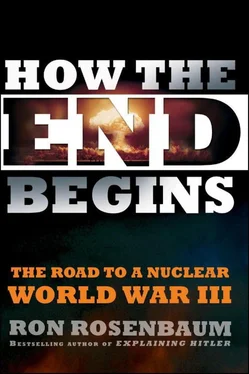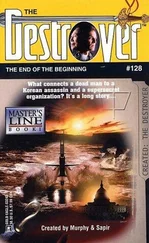We turned to the subject of the nuclear sub problem—the problem of commanders launching on their own authority. Letters of Last Resort and the like. What makes subs different from land-based nuclear weapons is the difficulty of close communication with vessels that seek to conceal their location in the most remote depths of the ocean. That concealment means they have to carry the targeting software with them on board and cannot depend on getting a burst of codes authorizing a launch through a deep sea barrier. Again the insoluble paradox: the more you centralize, limit the subs’ ability to act on their own, the more you make yourself vulnerable to losing the ability to execute a sub launch order in a cutoff scenario. The more you give the sub commander individual authority in case of a cutoff, the more you risk him launching on his own.
I asked Blair, “I’ve heard or read that submarine commanders had more independent authority to launch than land-based because of the difficulty of communication.”
“The procedures would be different but they’re not delegated independent authority to fire. They always, from the beginning, have been required to receive a valid launch order to fire.”
“They’re required,” I said, “but they’re capable of doing it alone?”
“But they’ve been capable just like we were capable with the Minuteman into the 1970s. Bombers were capable until 1971. Minuteman until 1976 or 1977.”
“What happened in those cases?”
“Locks were installed of various kinds and then on submarines they were finally installed in 1997.”
Not till then—why?
“Those locks were installed as a result of the investigation that revealed problems of unauthorized launch possibilities on nuclear submarines that also uncovered an electronic backdoor.”
Blair said that in 1998 the Navy came across an electronic backdoor in the naval broadcast communications system network that would allow unauthorized people, including hackers and terrorists, to seize electronic control over the radio stations that were used to transmit launch orders to (nuclear-armed) submarines. If you hacked the right codes, he says “you could inject a valid launch order, you could seize control and transmit a launch command to the submarines.” [170]
Has this ever been reported on?
“A little bit. Basically because I’ve written up stuff in my obscure writings and people like you come along occasionally and pick up on it but nothing really widely circulated.”
“It’s interesting,” I said. “As late as 1998 we’re still discovering problems and serious ones. How confident should we be at this point that there aren’t as yet undiscovered serious problems. Or do you think there still are?”
“I think there are and,” he added, “I think there always will be.”
He became convinced of this during his period as a congressional investigator when Congress focused not on the substance of his testimony—there was “fundamental doubt on the ability of the United States to implement… [the] doctrine of comprehensive retaliation,” he testified—but on his ability to have peered into the secret system in the first place.
Talking to Blair I felt somewhat like Dante being guided by Virgil down into the circles of nuclear chain of command hell. Blair meanwhile looks to Major Hering for his inspiration.
“No one has yet come up with an answer to Major Hering’s question,” Blair told me, the one about how one could know whether a presidential launch order, however legitimate in every other way, come from a sane president.
And it’s become even more urgent now in the multipolar second nuclear age that features regional nuclear powers, rogue states, terrorists, and renewed U.S.–Russian hostility.
“We still have missiles in Montana and in Siberia that will fire as soon as they get a short stream of computer signals,” Blair says. “I’m particularly concerned about them continuing to maintain these postures on hair-trigger alert in the context of the new frontier of warfare, which is cyber-space and cyber-warfare. The advent of the computer age has changed everything in the military business. We are so dependent now on computers and on the security of computers—that they can cause war to break out by cyber-attack or cyber-failure.”
“That 1998 backdoor launch vulnerability as a harbinger?” I asked.
“That was the leading edge into the realization of vulnerabilities,” he says.
It gives additional urgency to plans to bring the still vast nuclear arsenals of the superpowers back from the brink. And one man, Blair’s former Russian counterpart, Valery Yarynich, believes he has a solution.
CHAPTER SIX
COLONEL YARYNICH’S “100 NUCLEAR WARS” AND THE APOCALYPSE EQUATION
FROM RUSSIA WITH COMPLICATIONS
After spending some time with Colonel Valery E. Yarynich one realizes something: thirty years in the Soviet Strategic Rocket Force and on the Soviet General Staff, its military command hierarchy, can do something to a man. One thing it can do is give him a deep-dyed black-humored sense of the absurd. The man in question was someone, after all, who may have saved the world from nuclear war with a statistical device known as “Monte Carlo runs.”
That sense of absurdity is what I found almost endearing about Colonel Yarynich, an otherwise stern and sober-minded high-level strategic nuclear war planner, when we finally met in December 2008. Yarynich was not only one of the architects of the PERIMETR system but the author of a remarkable book— C3: Nuclear Command, Control, Cooperation [171]—written during the brief moment after the Cold War when Russians and Americans were working hard to climb down from their respective nuclear ledges. His 2003 book is packed with astonishingly detailed descriptions and diagrams of how the Soviets and their Russian Federation successors for a dozen years after the fall prepared to fight a global nuclear war. It contains the sort of secrets that spies of a previous generation would have given their lives for. [172]
It was through Yarynich’s book that the West learned the details of PERIMETR: how it used technology, electronic telemetry (dual phenomenology), and the like to ensure retaliation should the Russians face a decapitated chain of command. [173]
His intent at the time was to encourage us to build our own PERIMETR system with the idea that two such systems facing each other would stabilize deterrence should some mad leader or leaders think they could get away with a successful (retaliation-free) surprise attack decapitation. [174]The cover of his black-bound tech-heavy book about the architectonics of nuclear war features a photo of two hands in a firm handclasp, each hand touchingly identified as, respectively, “United States” and “Russia.” Both of the hands are cut off at the wrists—unintentionally, one might suppose.
That fear of decapitation reached its height when the Soviet leader Yuri Andropov raged in the Kremlin in early 1980s, lashing his bleary-eyed former KGB colleagues to stay up all night in every capital of Europe counting the lights in the windows of Western foreign ministries: a sudden increase in lights on would mean, Andropov believed, the imminence of a surprise attack. [175]The successful campaign by the Reagan administration to convince NATO to station advanced intermediate-range ballistic missiles (IRBMs) of the Pershing II class on European soil, had made the Soviets edgy even before the first of the Pershings were to arrive in late November 1983.
To the U.S. and its allies, the missiles were defensive insurance against Western Europe being overwhelmed by Warsaw Pact conventional arms superiority. To Moscow, the Pershings were potential offensive weapons of decapitation, as little as seven minutes from cutting off the head of the nuclear chain of command in Moscow.
Читать дальше











